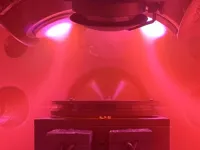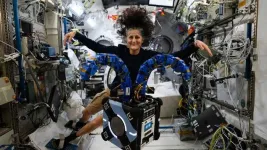(Press-News.org) EAST LANSING, Mich. – If you like the smell of spring roses, the sounds of summer birdsong and the colors of fall foliage, you have the stabilization of the ozone layer to thank for it. Located in the stratosphere where it shields the Earth from harmful ultraviolet radiation, the ozone layer plays a key role in preserving the planet’s biodiversity.
Now, we may have a better idea of why that took more than 2 billion years to happen.
Michigan State University researcher Dalton Hardisty contributed to a new Yale University-led study finding that Earth’s early atmosphere hosted a battle royal between iodine and oxygen. This war effectively delayed the creation of a stable ozone layer that would shield complex life from much of the sun’s ultraviolet radiation, or UVR.
The new theory, described in a study in the journal may solve a mystery that has puzzled scientists for hundreds of years.
“This was a fun interdisciplinary team that really challenged what we thought we knew about the establishment of Earth’s atmospheric ozone layer, which has wide-ranging implications,” said Hardisty, assistant professor in the College of Natural Science’s Department of Earth and Environmental Sciences. “A major contribution from MSU includes my research group’s work constraining the geochemical cycling of iodine in seawater today and across Earth history. Marine iodine cycling had not been previously considered in ancient ozone models despite its known importance for ozone chemistry today. Our work at MSU was an important context for bridging this gap.”
Indeed, scientists have long wondered why land plants did not emerge on Earth until 450 million years ago, even though their progenitors, cyanobacteria, had been in existence for 2.7 billion years. Likewise, there are no fossils for complex land animals or plants before the Cambrian era (541 to 485 million years ago) despite the evidence of much older microfossils.
“The origin and diversification of complex life on Earth remains one of the most profound and enduring questions in natural science,” said Jingjun Liu, a Yale doctoral student and first and corresponding author of the study.
The new study suggests that something beyond the need for time was responsible: the delayed stabilization of Earth’s ozone layer, caused by elevated marine iodine concentrations that prevented a protective UVR shield from forming in the atmosphere.
Ozone production depends on atmospheric oxygen and background UVR. It has been widely accepted by scientists that once Earth established a substantial concentration of atmospheric oxygen, the planet formed an ozone layer that allowed for biological evolution to proceed unimpeded.
“We challenge this paradigm by considering how Earth’s evolving iodine cycle may have influenced ozone abundance and stability,” Liu said.
For the study, Hardisty collaborated with a research team that analyzed multiple lines of independent geological evidence and developed an ocean-atmosphere model to reconstruct the iodine-ozone dynamics for the early Earth. The researchers found that elevated marine iodide content compared to today’s levels prevailed through most of Earth’s history, which would have led to significant inorganic iodine emissions into the atmosphere after the rise of oxygen — with the potential for disrupting ozone.
The mechanism of ozone destruction by iodine is similar to the process by which chlorofluorocarbons, or CFCs, created the “ozone hole” over Antarctica. When CFCs undergo photolysis, they release reactive chlorine, which catalytically destroys ozone in the stratosphere — and that’s what led to as much as a 50% depletion in the ozone layer over continental Antarctica at the peak of the problem.
Liu noted that at a global scale, unstable and low ozone levels likely persisted from 2.4 billion years ago until roughly half a billion years ago.
By Michael Greenwood and Bethany Mauger
###
Michigan State University has been advancing the common good with uncommon will for more than 165 years. One of the world’s leading public research universities, MSU pushes the boundaries of discovery to make a better, safer, healthier world for all while providing life-changing opportunities to a diverse and inclusive academic community through more than 400 programs of study in 17 degree-granting colleges.
For MSU news on the web, go to MSUToday or x.com/MSUnews.
END
New MSU study explains the delayed rise of plants, animals on land
2025-01-08
ELSE PRESS RELEASES FROM THIS DATE:
UTA becomes one of largest natural history libraries
2025-01-08
Thanks to in-kind donations of tens of thousands of rare books, scientific journals, and articles, and reports over the past two years, The University of Texas at Arlington’s Amphibian and Reptile Diversity Research Center (ARDRC) has become one of the largest publicly accessible herpetology libraries in the world.
“Thanks to 12 independent donors, including the Joseph Rex Dinardo Jr. Herpetology and Natural History Science Research Trust in Philadelphia, Dr. Jonathan Campbell, William Lamar, Drs. Jay and Rebecca Savage, and Louis Porras, we now have thousands ...
Number of autistic individuals enrolled in Medicaid and receiving federal housing support increased by 70% from 2008-16
2025-01-08
Affordable and stable housing is critical to improving health across a person's lifespan. People with disabilities, including autism, comprise a significant share of people in need of housing assistance. However, the intersection of housing and health among individuals with autism is largely unknown because data on public housing and public health are not connected. Researchers from Drexel University’s A.J. Drexel Autism Institute examined how many autistic people in the United States received housing ...
St. Jude scientists create scalable solution for analyzing single-cell data
2025-01-08
Researchers have amassed vast single-cell gene expression databases to understand how the smallest details impact human biology. However, current analysis methods struggle with the large volume of data and, as a result, produce biased and contradictory findings. Scientists at St. Jude Children’s Research Hospital created a machine-learning algorithm capable of scaling with these single-cell data repositories to deliver more accurate results. The new method was published today in Cell Genomics.
Before single-cell analysis, bulk gene expression data ...
What is the average wait time to see a neurologist?
2025-01-08
MINNEAPOLIS – Older people wait an average of just over a month to see a neurologist for specialty care after being referred by their primary care physician or another physician, according to a study published in the January 8, 2025, online issue of Neurology®, the medical journal of the American Academy of Neurology. The study, which looked at people who have Medicare insurance, also found some people wait more than three months to see a neurologist.
“Neurologists provide important and ongoing care for people ...
Proximity effect: Method allows advanced materials to gain new property
2025-01-08
UNIVERSITY PARK, Pa. — Ferroelectrics are special materials with polarized positive and negative charges — like a magnet has north and south poles — that can be reversed when external electricity is applied. The materials will remain in these reversed states until more power is applied, making them useful for data storage and wireless communication applications.
Now, turning a non-ferroelectric material into one may be possible simply by stacking it with another ferroelectric material, according to a team led by scientists from Penn State who demonstrated the phenomenon, called proximity ferroelectricity.
The ...
LJI researchers shed light on devastating blood diseases
2025-01-08
LA JOLLA, CA—Scientists at La Jolla Institute for Immunology (LJI) have discovered how a mutated gene kicks off a dangerous chain of events during blood cell production.
The study, published recently in the Proceedings of the National Academy of Sciences, reveals how a mutated gene called ASXL1 is involved in a disease called clonal hematopoiesis, a precursor to malignant diseases such as myeloid malignancies and chronic monomyelocytic leukemia.
"We know that many diseases—and all cancers—are driven by mutations in the genome," says LJI Instructor Zhen Dong, ...
ISS National Lab announces up to $650,000 in funding for technology advancement in low Earth orbit
2025-01-08
KENNEDY SPACE CENTER (FL), January 7, 2025 – The International Space Station (ISSInternational Space Station) National Laboratory is soliciting flight concepts for technology advancement that utilizes the space-based environment of the orbiting laboratory. This solicitation, “Technology Advancement and Applied Research Leveraging the ISS National Lab,” is open to a broad range of technology areas, including chemical and material synthesis in space, translational medicine, in-space edge computing, and in-space servicing, assembly, and manufacturing. It also encompasses the application of space station remote sensing data to improve geospatial analytics ...
Scientists show how sleep deprived brain permits intrusive thoughts
2025-01-08
A new study has shown that sleep deprivation can inhibit the brain’s ability to suppress unwanted memories and intrusive thoughts.
Scientists at the University of York, in collaboration with the University of East Anglia, have shown that sleep deprivation interferes with the ability of the prefrontal area of the brain to restrict the retrieval of memories that would have otherwise been suppressed.
Dr Scott Cairney from the University of York said: “Memories of unpleasant experiences often intrude into our conscious ...
UC Irvine-led team discovers potential new therapeutic targets for Huntington’s disease
2025-01-08
Irvine, Calif., Jan. 8, 2025 — A University of California, Irvine-led research team has discovered intricate molecular mechanisms driving the RNA processing defects that lead to Huntington’s disease and link HD with other neurodegenerative disorders such as amyotrophic lateral sclerosis, frontotemporal lobar dementia and Alzheimer’s disease.
The findings may pave the way for neurodegenerative disorder researchers to collaborate and share therapeutic strategies across diseases, opening additional avenues for treatment.
While it’s known that HD is caused by an abnormal ...
Paul “Bear” Bryant Awards 2024 Coach of the Year finalists named
2025-01-08
HOUSTON, January 8, 2025 — Eight active college football coaches make up the American Heart Association’s 2024 Paul “Bear” Bryant Coach of the Year Award finalist list. The award is given each January to a college football coach for contributions that make the sport better for athletes and fans alike by demonstrating grit, integrity and a winning approach to coaching and life – both on and off the field. The Paul “Bear” Bryant Coach of the Year Award is the only college football coaching honor ...



